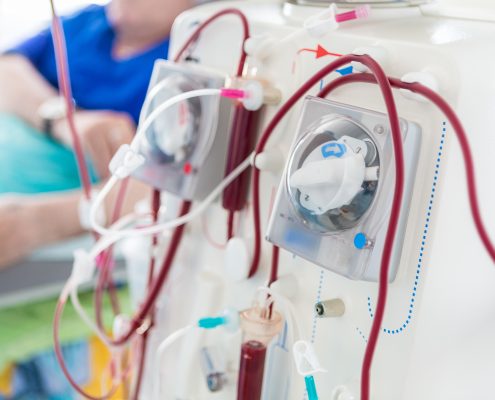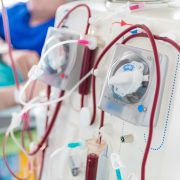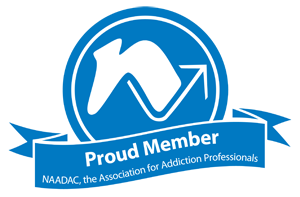End-Stage Renal Disease (ESRD) – Diagnosis, Progression and Treatment (part 1)
Brief Epidemiology of End- Stage Renal Disease (ESRD)
End-stage renal disease (ESRD) is the final stage of kidney failure that affects at least 230,000 individuals in the United States (Blake, Toker, Dickerman & Dunn, 2002). Some of the primary causes of ESRD include diabetes (34.47%), hypertension (25.1%), glomerulonephritis (16.4%), Cystic Kidney (4.69%) and 16.39% are due to unknown or miscellaneous causes (National Kidney Foundation, 2016). With older age additional age-related comorbid diseases also come into play (Brown and Johansson, 2011).

Disease progression and treatment
ESRD is the final stage of kidney failure. There are two types of ESRD treatment: dialysis and kidney transplant. Dialysis treatments consist of the removal of toxins and extra fluid from the body (Billington, Simpson, Unwin, Bray, & Giles, 2008). The NKF (2016) reports that more than 193,000 patients currently living in the United States have had a kidney transplant. Although a kidney transplant is the most desired type of Replacement Real Therapy (RRT), kidney transplant donors are generally limited with the organs typically “reserved” for the healthies of ESRD individuals (Billington et al., 2008). To add to that, there is also a very high rate of transplant failure averaging 61% (Billington et al., 2008).
Since obtaining a kidney transplant is not a viable options for all patients, a hemodialysis treatment have been one of the most commonly used approaches for individuals diagnosed with ESRD to maintain their conditions over time (Billington et al., 2008). The National Institute of Diabetes and Digestive and Kidney Disease (2016) reports that from the 398,861 patients who suffer from ESRD, the vast majority undergo hemodialysis (HD) treatments at a clinic as compared to those who employ peritoneal dialysis (PD) and home HD treatments combined. Brown and Johansson (2011) bring attention to the fact that even though the default treatment approach to chronic kidney disease is an in-center hemodialysis treatment, research has found that peritoneal dialysis has shown better results especially with the elderly population. Patients who are under peritoneal dialysis are able to travel, they are able to have their treatments at their convenience in their own home, and they skip the trips to the hemodialysis clinics and generally enjoy an active social life (Brown & Johansson, 2011).
Patel, Peterson and Kimmel (2005) described the limitations that patients undergoing hemodialysis treatments experience. For instance, patients are unable to work and travel, and they also have limited interactions with family and friends (Patel, Peterson &Kimmel, 2005). Additionally, the same authors also point to correlations between social support, depression and mortality rates, and the patient’s compliance with their medical treatment (Patel, Peterson & Kimmel, 2005). Wells and Anderson (2011) argue that ESRD clients whose results rate high on social support and self-efficacy have the potential to improve their health outcomes and are better able to cope with the stressors caused by ESRD. When it comes to ESRD, compliance with treatment is indeed crucial (Wells & Walker, 2012). Research shows that older adults tend to be more adherent to treatments especially regarding intradialytic weigh gain (IDWG) and potassium levels (Wells & Walker, 2012).

Knowledge of human behavior and the social environment
When clients are diagnosed with ESRD there are typically in shock and denial. Being diagnosed with a ESRD is a traumatic experience, there’s no question about it. Individuals are already in frail conditions, and admit that thoughts about possible death plagued them for a while. Feelings of hopelessness and helplessness for a long period of time after the initial discovery are also common. It is not surprising to hear that during that stage, patients feel drained from the constant worry about their future, children and loss of job income.
As typically occurs with patients who have been diagnosed with a debilitating condition, once the shock and denial phase passes, clients are able to adjust their life to a point where they are able to accept their situation. From not wanting to discuss their hemodialysis treatments with friends or family, a topic already addressed by Nicholas, Picone and Selkirk’s study (2011), patients do overcome their feelings of fear and hopelessness. Some of them even become advocates, able to encourage and motivate patients who are newly diagnosed with ESRD.
It is not uncommon for patients to give up their businesses or leave work as the disease makes it impossible for them to perform daily tasks. The three hemodialysis’ treatments per week are very exhausting, with clients feeling extremely sick and unable to cope not only with the treatment itself, but also with the dietary and fluid restrictions. And in fact, ESRD is a brutal disease leaving patients wondering if they would be better off without treatment. Hackett and Watnick (2007) report that the third leading cause for mortality in the dialysis population has been found to be the withdrawal from medical treatment. This holds true for some patients who report that at times they did not believe they could make it and has had to “lean on” their families for courage and support.
Theoretical framework for those individuals diagnosed with ESRD
The self-regulation theory is based on the famous Leventhal’s Common Sense Model (CSM). According to Jansen, Heijmans, Rijken and Kaptein (2011) when people are faced with a health related threat, they make cognitive representations relating to that threat. These cognitive schemas include several categories such as the name and related symptoms of the illness; what causes the disease and how long it would last, and what the personal consequences would be for both the individual and his or her mate (Jansen et al., 2011). The cognitive schemas created by patients influence how they will be able to cope with the illness not only psychologically but also emotionally.
According to the Self-Determination theory (SDT), individuals function at their prime level when autonomy drives them to fulfil desired goals and it also brings psychological health (Jansen et al., 2011). When an individual’s sense of autonomy is being deprived, feelings of loss and low-self-esteem come in to play and their self-worth being questioned (Jansen et al., 2011). Autonomy is an important factor when dealing with patients on dialysis. Research has found that patients on dialysis feel limited autonomy due to the fact that they do not have the freedom to engage in activities they would like to do because of their condition (Jansen et al., 2011). Indeed, hemodialysis treatments are not only time consuming (4 hours treatments, three times per week) but also lead to patients feeling drained and washed out with little energy to stay active.
Social support is critical, when patients feel supported by family and friends they generally are more adherent to their dialysis treatment, which in turn may stimulate their sense of autonomy and self-worth (Jansen et al., 2011). Having a healthy support system is indeed important. Low, Smith, Burns, and Jones, (2008) draw the parallel that even though it is known that caretakers who are in a healthy state of mind positively affect patients suffering from ESRD, little to no research has been done to address this relationship.
The final theory that helps us to better understand patients suffering from ESRD is the Social Learning theory by Bandura. This theory is based on the foundational strategies of self-efficacy and expectation of outcomes (Jansen et al., 2011). Patients have the potential to change negative thought patterns and maladaptive behaviors by using modeling, self-monitoring skills and problem-solving techniques (Jansen et al., 2011). This is especially crucial for ESRD patients in areas such as finding a job and feeling productive.
For this and more information regarding dealing with ESRD, please stay tuned. Part 2 will be posted next week.
Do you know that Freedom Counseling is on social media? Follow us on Instagram @freedomcounseling, Facebook & Pinterest (Freedom Counseling)
Become Who You Are
References
Atkinson, M. A., Neu, A. M., Fivush, B. A., & Frankenfield, D. L. (2008). Disparate outcomes in pediatric peritoneal dialysis patients by gender/race in the End-Stage Renal Disease Clinical Performance Measures project. Pediatric Nephrology, 23(8), 1331-1338. doi:10.1007/s00467-008-0832-z
Billington, E., Simpson, J., Unwin, J., Bray, D., & Giles, D. (2008). Does hope predict adjustment to end-stage renal failure and consequent dialysis?. British Journal Of Health Psychology, 13(4), 683-699. doi:10.1348/135910707X248959
Blake, A., Toker, S., Dickerman, R., & Dunn, E. (2002). Trauma management in the end-stage renal disease patient. The American Surgeon, 68(5), 425.
Brown, E. A., & Johansson, L. (2011). Epidemiology and management of end-stage renal disease in the elderly. Nature Reviews Nephrology, (10), 591.
Chilcot, J., Wellsted, D., & Farrington, K. (2010). Depression in End-Stage Renal Disease: Current Advances and Research. Seminars In Dialysis, (1), 74.
Crews, D. C., Charles, R. F., Evans, M. K., Zonderman, A. B., & Powe, N. R. (2010). Original Investigation: Poverty, Race, and CKD in a Racially and Socioeconomically Diverse Urban Population. American Journal Of Kidney Diseases, 55992-1000. doi:10.1053/j.ajkd.2009.12.032
Cukor, D. P. (2007). Use of CBT to Treat Depression Among Patients on Hemodialysis. Psychiatric Services, (5), 711. doi:10.1176/ps.2007.58.5.711
Duarte, P. S., Miyazaki, M. C., Blay, S. L., & Sesso, R. (2009). Cognitive–behavioral group therapy is an effective treatment for major depression in hemodialysis patients. Kidney International, 76(4), 414-421. doi:10.1038/ki.2009.156
Hackett, A. S., & Watnick, S. G. (2007). Withdrawal from Dialysis in End-Stage Renal Disease: Medical, Social, and Psychological Issues. Seminars In Dialysis, 20(1), 86-90. doi:10.1111/j.1525-139X.2007.00249.x
Hughes, J., Wood, E., & Smith, G. (2009). Exploring kidney patients’ experiences of receiving individual peer support. Health Expectations: An International Journal Of Public Participation In Health Care & Health Policy, 12(4), 396-406. doi:10.1111/j.1369-7625.2009.00568.x
Jansen, D. L., Heijmans, M., Rijken, M., & Kaptein, A. A. (2011). The development of and first experiences with a behavioural self-regulation intervention for end-stage renal disease patients and their partners. Journal Of Health Psychology, 16(2), 274-283. doi:10.1177/1359105310372976
Kovacs, P. p., Perkins, N., Nuschke, E., & Carroll, N. (2012). How End-Stage Renal Disease Patients Manage the Medicare Part D Coverage Gap. Health & Social Work, 37(4), 225-233
Low, J., Smith, G., Burns, A., & Jones, L. (2008). The impact of end-stage kidney disease (ESKD) on close persons: a literature review. NDT Plus, 1(2), 67-79. doi:10.1093/ndt-plus/sfm046
Nicholas, D. B., Picone, G., & Selkirk, E. K. (2011). The lived experiences of children and adolescents with end-stage renal disease. Qualitative Health Research, 21(2), 162-173. doi:10.1177/1049732310382789
Nicholas, S. B., Kalantar-Zadeh, K., & Norris, K. C. (2015). Article: Socioeconomic Disparities in Chronic Kidney Disease. Advances In Chronic Kidney Disease, 22(Socioeconomics, Disparities, and the Kidney), 6-15. doi:10.1053/j.ackd.2014.07.002
Patel, S. S., Peterson, R. A., & Kimmel, P. L. (2005). The Impact of Social Support on End-Stage Renal Disease. Seminars In Dialysis, 18(2), 98-102. doi:10.1111/j.1525-139X.2005.18203.x
Wells, J. R., & Anderson, S. T. (2011). Self-Efficacy and Social Support in African Americans diagnosed with End Stage Renal Disease. ABNF Journal, 22(1), 9-12 4p.
Wells, J. R., & Walker, C. A. (2012). Factors Influencing Adherence in African Americans with End Stage Renal Disease. Journal Of Theory Construction & Testing, 16(2), 52-56.
Williams, A. W. (2015). Article: Health Policy, Disparities, and the Kidney. Advances In Chronic Kidney Disease, 22(Socioeconomics, Disparities, and the Kidney), 54-59. doi:10.1053/j.ackd.2014.06.002














Leave a Reply
Want to join the discussion?Feel free to contribute!